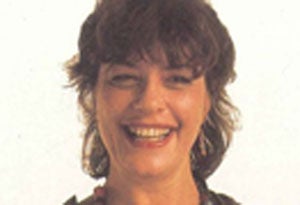Susan Collier: Award-winning textile designer best known for her work for Liberty and Habitat

Swathed from head to calf-length hem in the gorgeous stuffs she designed herself, Susan Collier was unmissable. You noticed her gaudy turban before taking in her full skirt, noted that you had seen some of these textiles in the window of Liberty, and were captivated by the smoky voice and laughter of their wearer and maker. These materials were familiar because they were classics of textile design, and you – or someone you knew – very likely owned a set of Collier Campbell sheets, or curtains, or a scarf, if not an Yves Saint Laurent, Bill Gibb or Jean Muir frock in cloth made by the partnership of Susan and her sister Sarah Campbell. Their fabrics were everywhere, from the catwalk to Marks & Spencer's best-selling duvet cover. The firm is 50 years old this year, and the pity is that Susan died of cancer just before a Collier Campbell retrospective exhibition opened at the National Theatre (it runs until 10 July), showcasing some of the best known prints of the second half of the 20th century.
Susan was born in Manchester to Patience Collier, the actress, and Harry Collier, the pharmacologist. (Her brother is Joe Collier, the campaigning pharmacologist, and her first husband another eminent pharmacologist, Andrew Herxheimer.) Her father took her for long walks to look at plants and insects, teaching her to concentrate for example, on the wings of a butterfly; and her mother, who gave her her first paints and brushes, painted Susan's chair the Matisse-inspired shades of red and yellow the child demanded. Shopping for textiles proved a dreary experience that convinced her she could become "a painter of textiles."
Self-taught, Collier had a triumph in 1961 when she sold six designs from her portfolio to Liberty, and they commissioned more. With her sister Sarah Campbell, who had been to art school, she sent up a freelance design studio. In 1971 Collier was appointed Liberty's design and colour consultant over fabrics, as well as decorative materials, apparel and accessories, and Campbell was retained as its designer. These appointments allowed Liberty to transform its business, by selling to Europe and to the new "ready-to-wear" of collections of Yves Saint Laurent, Cacharel, Daniel Hechter and others. But Collier Campbell also revitalised Liberty's decorative fabrics, by introducing the palette of high fashion into home furnishings. Sales to furniture manufacturers boomed, and English houses burst into colour with Collier Campbell classic designs such as "Côte d'Azur," "Bauhaus," "Tambourine Stripe" and "Cottage Garden." Their work allowed Liberty to transform the firm from a manufacturer of prints with limited runs into a major wholesaler of printed fabric.
During the 1970s Collier Campbell pioneered the clothing catalogue business, selling dynamic and wearable clothes direct to customers. In 1974 Terence Conran's Habitat commissioned Collier Campbell to design their textile Lifestyle look; by 1980 they were Habitat's major textile converter, buying greige cloth (unbleached and undyed) at competitive prices, then designing and printing it. They sold cloth to Marks & Spencer, creating "Tapestry" for them, one of the first overall ranges for home furnishings. In 1984 they won the Duke of Edinburgh's prize for design for their "Six Views" collection, and in 1988 Conran commissioned them to design the carpets for the new North Terminal at Gatwick.
Collier and Campbell continued to paint all their designs, even though improvements had been made to printing technique, and of course, it became possible to use computers in design. Collier's motto, though, was "cheat the repeat." By this she meant that hand-painting allowed enormous and rich variations of colour and rhythm that mechanical processes could not achieve. She was politically motivated, she said, to produce beautiful cloth for the mass market. You can imagine her saying this portentously and then whooping with laughter at her own seriousness.
She had an essentially sunny nature and an ironically comic view of life. Laughter and pleasure were what most guests will remember from meals and parties at the stunning Queen Anne house in Clapham Old Town she had bought, practically ruined, in 1969 and restored, with its secret garden at the back. She made equally handsome gardens at the two further south London houses she lived in after Clapham.
In 1961 she married Andrew Herxheimer, with whom she had two daughters, Sophie and Charlotte. Sophie said "her sense of humour is one of the things I will really miss the most, growing up with her was hysterically funny... And of course she was a phenomenal cook, a tradition to aspire to. Luckily she taught Charlotte and me a huge amount of practical stuff, getting us to make pastry, salad dressings, bread, with her usual verve and attentiveness to detail, checking and tasting, never stinting, just like in her lovely, lively work."
For many years in the 1970s Susan was with the painter, Martin Fuller. Her second marriage, to the writer and broadcaster, Frank Delaney, was also dissolved.
Paul Levy
Susan Jane Collier, textile designer: born Manchester 12 October 1938; married 1961 Andrew Herxheimer (divorced 1972; two daughters), 1988 Frank Delaney (divorced 1994); died London 18 May 2011.
Join our commenting forum
Join thought-provoking conversations, follow other Independent readers and see their replies
Comments